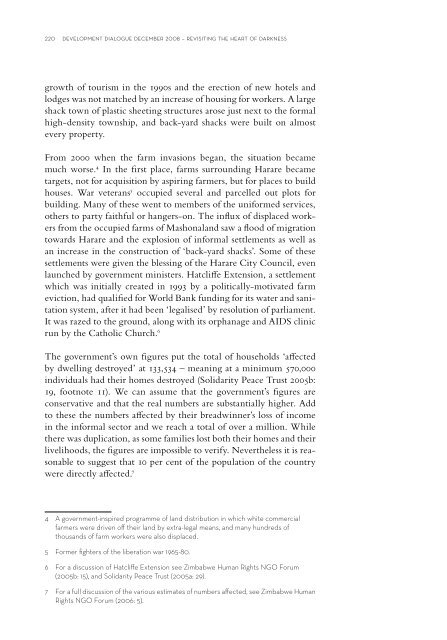60 years after the UN Convention - Dag Hammarskjöld Foundation
60 years after the UN Convention - Dag Hammarskjöld Foundation
60 years after the UN Convention - Dag Hammarskjöld Foundation
You also want an ePaper? Increase the reach of your titles
YUMPU automatically turns print PDFs into web optimized ePapers that Google loves.
220 development dialogue december 2008 – revisiting <strong>the</strong> heart of darkness<br />
growth of tourism in <strong>the</strong> 1990s and <strong>the</strong> erection of new hotels and<br />
lodges was not matched by an increase of housing for workers. A large<br />
shack town of plastic sheeting structures arose just next to <strong>the</strong> formal<br />
high-density township, and back-yard shacks were built on almost<br />
every property.<br />
From 2000 when <strong>the</strong> farm invasions began, <strong>the</strong> situation became<br />
much worse. 4 In <strong>the</strong> fi rst place, farms surrounding Harare became<br />
targets, not for acquisition by aspiring farmers, but for places to build<br />
houses. War veterans 5 occupied several and parcelled out plots for<br />
building. Many of <strong>the</strong>se went to members of <strong>the</strong> uniformed services,<br />
o<strong>the</strong>rs to party faithful or hangers-on. The infl ux of displaced workers<br />
from <strong>the</strong> occupied farms of Mashonaland saw a fl ood of migration<br />
towards Harare and <strong>the</strong> explosion of informal settlements as well as<br />
an increase in <strong>the</strong> construction of ‘back-yard shacks’. Some of <strong>the</strong>se<br />
settlements were given <strong>the</strong> blessing of <strong>the</strong> Harare City Council, even<br />
launched by government ministers. Hatcliff e Extension, a settlement<br />
which was initially created in 1993 by a politically-motivated farm<br />
eviction, had qualifi ed for World Bank funding for its water and sanitation<br />
system, <strong>after</strong> it had been ‘legalised’ by resolution of parliament.<br />
It was razed to <strong>the</strong> ground, along with its orphanage and AIDS clinic<br />
run by <strong>the</strong> Catholic Church. 6<br />
The government’s own fi gures put <strong>the</strong> total of households ‘aff ected<br />
by dwelling destroyed’ at 133,534 – meaning at a minimum 570,000<br />
individuals had <strong>the</strong>ir homes destroyed (Solidarity Peace Trust 2005b:<br />
19, footnote 11). We can assume that <strong>the</strong> government’s fi gures are<br />
conservative and that <strong>the</strong> real numbers are substantially higher. Add<br />
to <strong>the</strong>se <strong>the</strong> numbers aff ected by <strong>the</strong>ir breadwinner’s loss of income<br />
in <strong>the</strong> informal sector and we reach a total of over a million. While<br />
<strong>the</strong>re was duplication, as some families lost both <strong>the</strong>ir homes and <strong>the</strong>ir<br />
livelihoods, <strong>the</strong> fi gures are impossible to verify. Never<strong>the</strong>less it is reasonable<br />
to suggest that 10 per cent of <strong>the</strong> population of <strong>the</strong> country<br />
were directly aff ected. 7<br />
4 A government-inspired programme of land distribution in which white commercial<br />
farmers were driven off <strong>the</strong>ir land by extra-legal means, and many hundreds of<br />
thousands of farm workers were also displaced.<br />
5 Former fi ghters of <strong>the</strong> liberation war 1965-80.<br />
6 For a discussion of Hatcliff e Extension see Zimbabwe Human Rights NGO Forum<br />
(2005b: 15), and Solidarity Peace Trust (2005a: 29).<br />
7 For a full discussion of <strong>the</strong> various estimates of numbers aff ected, see Zimbabwe Human<br />
Rights NGO Forum (2006: 5).

















